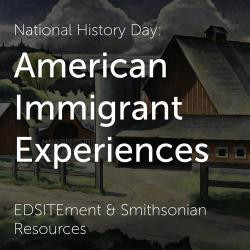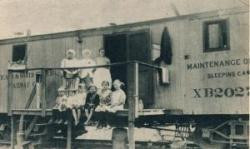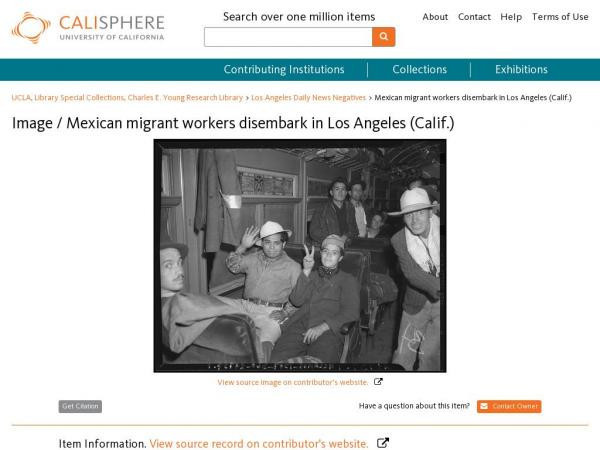Rubina Pantoja's collections
Domingo Ulloa's
<p>This teaching collection helps students to look closely and think critically by examining <em></em>Domigo Ulloa's painting, <em>Braceros, </em>and historical documentation related to the bracero program, a series of short-term labor contracts from 1942-1964 in which an estimated two million Mexican men came to the US to work on farms and roads. The collection prompts students to consider the program from a variety of perspectives, including individual, collective, social, economic, and political. </p>
<p>Included here are the painting, a bilingual video with Smithsonian American Art Museum (SAAM) curator E. Carmen Ramos, four suggested Thinking Routines - "See, Think, Wonder," "Step In, Step Out, Step Back," "The 3 Y's," and "Think, Feel, Care" - from Harvard's Project Zero Artful Thinking and Global Thinking materials, supporting digital content from the National Museum of American History, and a blogpost from SAAM of two DC student's written responses to the prompt, "What Domingo Ulloa's <em>Braceros </em>Means to Me." </p>
<p>For use in Social Studies, Spanish, English, and American History classes</p>
<p>#LatinoHAC #EthnicStudies</p>
<p>This collection supports Unit 1: Intersectionality of Economics, Politics, and Policy, of the Austin ISD Ethnic Studies Part B course.</p>
<p><em>This Smithsonian Learning Lab collection received Federal support from the Latino Initiatives Pool, administered by the Smithsonian Latino Center. </em></p>
<p><br /></p>
 Rubina Pantoja
Rubina Pantoja
10
Bracero Program: Unveiling Stories
<p>In this activity, students will examine photographs documenting the Bracero Program, the largest guest-worker program in US history. Started in 1942 as a temporary war measure to address labor demands in agriculture and railroads, the program allowed Mexican nationals to take temporary agricultural work in Texas, New Mexico, Arizona, California, and 24 other states. By the time the program ended in 1964, over 4.6 million contracts were awarded. </p>
<p>Using two Project Zero Global Thinking Routines - "Unveiling Stories" and "The 3 Ys" - students will analyze the stories these photographs tell about the experiences of braceros in this program, and the impact of these stories in multiple contexts. Additional resources (primary sources, a digital exhibition, and an article) and information on how to use these routines in the classroom can by found by clicking <em>Read More »</em>.</p>
<p>Keywords: mexican, immigration, work, migration, migrant workers, agriculture, reform, politics, government, leonard nadel, photojournalism, activity, inquiry strategy, global competency, global competence, latino, chicano, California, Arizona, New Mexico, Texas, Arkansas, 1940s, 40s, 1950s, 50s, 1960s, 60s
</p>
<p>#LatinoHAC #EthnicStudies</p>
 Rubina Pantoja
Rubina Pantoja
37
Mexican Art & U.S. History: Carmen Lomas Garza
<p>This collection will provide an opportunity for students to analyze artwork, read background information, and connect art with historical events. At the heart of this activity is artwork created by Latino artist Carmen Lomas Garza. These paintings reflect the experiences of Garza's family and Latino life in 1980s America. In addition to image analysis, teachers could extend an opportunity for students to identify and discuss connections between Garza's art and the Mexican American experience from the 1960s to the present. This collection includes:</p>
<ul><li>A timeline of U.S.-Mexican American relations</li><li>Video/audio of Reagan signing the 1986 Immigration Reform Control Act</li><li>And an overview of immigration reform via ABC-CLIO (requires subscription). </li></ul><p>#ethnicstudies #LISDSS</p>
<p>Texas Essential Knowledge and Skills Connections #TEKS</p>
<p style="margin-left:0px;"></p>
<ul><li>24A describe how the characteristics of and issues in U.S. history have been reflected in various genres of art, music, film, and literature;</li></ul><p></p>
<p></p>
 Rubina Pantoja
Rubina Pantoja
24
Los Angeles Latino Families Photo Project
<p>The Los Angeles Latino Families Photo Project was launched at the UCLA Chicano Studies Research Center (CSRC) spring 2012. It is an extension of an earlier initiative launched in 2007 to combat the invisibility of the Mexican American contribution to Los Angeles and California history predating the social movements of the 1960s and 1970s within textbooks, trade, and academic books and articles. With the generous support of the John Randolph Haynes and Dora Haynes Foundation, the CSRC was able to digitize close to 3,000 images from the Edward R. Roybal Papers and the Yolanda Retter Vargas Collection of Orphan Photographs. The first collection documents Edward Roybal’s public service career from the 1940s to the 1990s as a Los Angeles city councilman and a U.S. congressman. The second was collected by the previous librarian, Yolanda Retter-Vargas, who found the photographs at various flea markets. This collection consists of “orphan” photographs—images with no provenance information. They appear to belong to six families. Both collections have been completed and are available on the UCLA Digital Library. <br /><br />After completing this project we quickly realized that Los Angeles Latino history is incomplete without the stories of its citizens. The Los Angeles Latino Families Photo Project was developed as a way to fully capture the complexity of this city’s history as well as address the issue of preservation through the digitization of vulnerable image-based collections. The photographs found in this particular collection were digitized and preserved during a Friends of the Library workshop held at the Chicano Studies Research Center spring 2012. They highlight the day-to-day lives of Latinos and Latinas living in Los Angeles over time. They document their families' histories and cultures capturing their movements between the United States and Latin America. One of the project’s goals is to provide the opportunity for community members to contribute additional photographs and information for the archival record.</p>
<p>#LatinoHAC #ethnicstudies<br /></p>
 Rubina Pantoja
Rubina Pantoja
39
My ethnic studies musings
<p>This collection was started as a way to share resources related to Mexican American Studies. It has now morphed into a larger collection for anyone interested in ethnic studies. It is still very much a work in progress.</p>
 Rubina Pantoja
Rubina Pantoja
30





